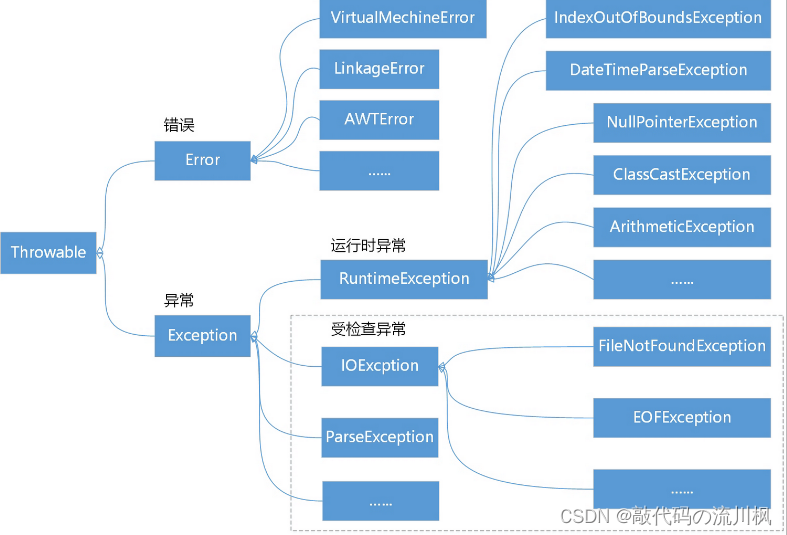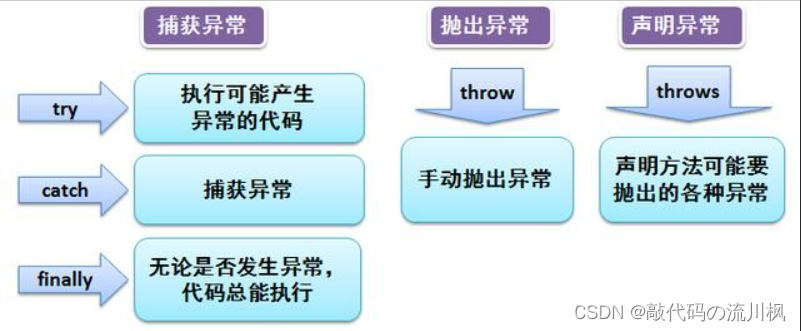1. 异常的概念与体系结构
1.1 异常的概念
什么是异常呢?
在java中,将程序执行过程中发生的不正常行为称为异常
java中不同类型的异常,都有与其对应的类来进行描述
接下来看看有哪些常见的异常:
1. 算术异常
public class Test {
public static void main(String[] args) {
System.out.println(10/0);
}
}

2. 数组越界异常
public class Test {
public static void main(String[] args) {
int[] arr = {0,1,2,3};
System.out.println(arr[100]);
}
}

3. 空指针异常
public class Test {
public static void main(String[] args) {
int[] arr = null;
System.out.println(arr.length);
}
}

4. 输入不匹配异常
import java.util.Scanner;
public class Test {
public static void main(String[] args) {
Scanner scanner = new Scanner(System.in);
int n = scanner.nextInt();
System.out.println(n);
}
}

1.2 异常的体系结构
Throwable:是异常体系的顶层类,其派生出两个重要的子类, Error和Exception
Error:指的是Java虚拟机无法解决的严重问题,比如:JVM的内部错误、资源耗尽等,典型代表:StackOverflowError和OutOfMemoryError
Exception:异常产生后程序员可以通过代码进行处理,使程序继续执行.我们平时所说的异常就是Exception

1.3 异常的分类
1. 编译时异常
在程序编译期间发生的异常,称为编译时异常,也称为受检查异常(Checked Exception)
程序想要编译,必须处理异常后才能继续编译
class Person{
private String name;
private String gender;
int age;
//想要让该类支持深拷贝,覆写Object类的clone方法即可
public Person clone(){
return (Person)super.clone();
}
}

2. 运行时异常
在程序执行期间发生的异常,称为运行时异常,也称为非受检查异常(Unchecked Exception)
运行时指的是程序已经编译通过得到class 文件了, 再由 JVM 执行过程中出现的错误
RunTimeException以及其子类对应的异常,都称为运行时异常。比如:NullPointerException、ArrayIndexOutOfBoundsException、ArithmeticException
2. 异常的处理
异常处理主要的5个关键字: throw、try、catch、final、throws

2.1 抛出异常throw
在Java中,可以借助throw关键字,抛出一个指定的异常对象,将错误信息告知给调用者。具体语法如下
throw new XXXException("异常产生的原因");
接下来我们写一个抛出异常的代码
public class Test {
public static void main(String[] args) {
int[] arr = null;
test(arr);
}
public static void test (int[] arrays){
if(arrays == null){
throw new NullPointerException("传递的数组为null");
}
}
}

注意事项:
throw必须写在方法体内部
抛出的对象必须是Exception 或者 Exception 的子类对象
如果抛出的是 RunTimeException 或者 RunTimeException 的子类,则可以不用处理,直接交给JVM来处理
如果抛出的是编译时异常,用户必须处理,否则无法通过编译
异常一旦抛出,其后的代码就不会执行
2.2 异常的捕获(throws 以及try-catch)
异常的捕获,也就是异常的具体处理方式,主要有两种:异常声明throws 以及 try-catch捕获处理
异常声明throws
当前方法不处理异常,提醒方法的调用者处理异常
即当方法中抛出编译时异常,用户不想处理该异常,此时就可以借助throws将异常抛给方法的调用者来处理
语法格式:
修饰符 返回值 类型 方法名(参数列表) throws 异常类型1,异常类型2...{
//...
}
注意事项
throws必须跟在方法的参数列表之后
声明的异常必须是 Exception 或者 Exception 的子类
方法内部如果抛出了多个异常,throws之后必须跟多个异常类型,之间用逗号隔开,如果抛出多个异常类型具有父子关系,直接声明父类即可
调用声明抛出异常的方法时,调用者必须对该异常进行处理,或者 继续使用throws抛出

public class Test {
public static void main(String[] args) throws Exception {
int[] arr = null;
test(arr);
}
public static void test(int[] arrays) throws Exception{
if(arrays == null){
throw new NullPointerException();
}
}
}
当test只声明了异常却没有处理,会向上寻找调用者即main函数,它也没有处理,则JVM处理异常
try-catch捕获并处理
throws对异常并没有真正处理,而是将异常报告给抛出异常方法的调用者,由调用者处理。如果真正要对异常进行处理,就需要try-catch
语法格式:
try {
//将可能出现异常的代码放在这里
//可能会抛出异常,也可能不会
}catch(要捕获的异常类型 e){
//如果try中的代码抛出异常了,此处catch捕获时异常类型与try中抛出的异常类型一致时,或者是try中抛出异常的基类时,就会被捕获到
//对异常就可以正常处理,处理完成后,跳出try-catch结构,继续执行后序代码
}
注意事项:
- try块内抛出异常位置之后的代码将不会被执行
public class Test {
public static void main(String[] args) throws Exception {
try {
int[] arr = null;
System.out.println(arr[3]);
System.out.println("hello world");
} catch (NullPointerException e) {
e.printStackTrace();
}
}
}
没有输出hello world

- 如果抛出异常类型与catch时异常类型不匹配,即异常不会被成功捕获,也就不会被处理,继续往外抛,直到JVM收到后中断程序----异常是按照类型来捕获的
抛出异常类型与catch时异常类型不匹配:
public class Test {
public static void main(String[] args) throws Exception {
try {
int[] arr = null;
System.out.println(arr[3]);
System.out.println("hello world");
} catch (ArithmeticException e) {
e.printStackTrace();
}
}
}

- try中可能会抛出多个不同的异常对象,则必须用多个catch来捕获----即多种异常,多次捕获
public class Test {
public static void main(String[] args) throws Exception {
try {
int[] arr = null;
System.out.println(arr[3]);
System.out.println("hello world");
} catch (ArithmeticException e) {
e.printStackTrace();
} catch (NullPointerException e){
e.printStackTrace();
} catch (ArrayIndexOutOfBoundsException e){
e.printStackTrace();
}
}
}
多个异常的处理方式是完全相同, 也可以写成这样:
public class Test {
public static void main(String[] args) throws Exception {
try {
int[] arr = null;
System.out.println(arr[3]);
System.out.println("hello world");
} catch (ArithmeticException | NullPointerException |ArrayIndexOutOfBoundsException e) {
e.printStackTrace();
}
}
}
异常之间具有父子关系,一定是子类异常在前catch,父类异常在后catch,否则语法错误
public static void main(String[] args) throws Exception {
try {
int[] arr = null;
System.out.println(arr[3]);
System.out.println("hello world");
} catch (ArithmeticException | NullPointerException |ArrayIndexOutOfBoundsException e) {
e.printStackTrace();
} catch (Exception e){
e.printStackTrace();
}
}
Exception可以捕获到所有异常
finally
有些特定的代码,不论程序是否发生异常,都需要执行;在程序正常或者异常退出时,必须要对资源进进行回收;异常还可能会引发程序的跳转,可能导致有些语句执行不到,就需要用到finally这个关键字了
语法格式
try {
//...
}catch(要捕获的异常类型 e){
//...
}finally{
//此处的语句无论是否发生异常,都会被执行到
//如果没有抛出异常,或者异常被捕获处理了,这里的代码也会执行
}
public static void main(String[] args) throws Exception {
try {
int[] arr = null;
System.out.println(arr[3]);
} catch (ArithmeticException | NullPointerException |ArrayIndexOutOfBoundsException e) {
e.printStackTrace();
} finally {
System.out.println("hello world");
}
}

finally 执行的时机是在方法返回之前(try 或者 catch 中如果有 return 会在这个 return 之前执行 finally). 但是如果finally 中也存在 return 语句, 那么就会执行 finally 中的 return, 从而不会执行到 try 中原有的 return
3. 总结
一个程序先执行 try 中的代码,如果 try 中的代码出现异常, 就会结束 try 中的代码, 看和 catch 中的异常类型是否匹配。如果找到匹配的异常类型,就会执行 catch 中的代码。如果没有找到匹配的异常类型,就会将异常向上传递到上层调用者。无论是否找到匹配的异常类型,finally 中的代码都会被执行到(在该方法结束之前执行)。如果上层调用者也没有处理异常, 就继续向上传递直到 main 方法也没有合适的代码处理异常, 就会交给 JVM 来进行处理,此时程序就会异常终止。
“ 本期的分享就到这里了, 记得给博主一个三连哈,你的支持是我创作的最大动力!


